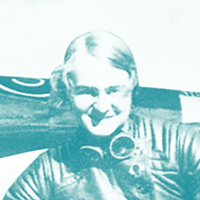Articles
Beatrice Shilling, aeronautical engineer
 During the Battle of Britain, the RAF had a problem. The Rolls-Royce Merlin engines on Spitfire and Hurricane fighter planes were shutting down after dives – a major issue in the swooping dogfights over the south of England. German pilots had no such issue, and could use this to their advantage during pursuits.
During the Battle of Britain, the RAF had a problem. The Rolls-Royce Merlin engines on Spitfire and Hurricane fighter planes were shutting down after dives – a major issue in the swooping dogfights over the south of England. German pilots had no such issue, and could use this to their advantage during pursuits.
According to The Spitfire Story by Alfred Price, the problem was caused by negative G-force manoeuvres forcing fuel to the top of the carburettor’s float chamber, instead of down into the engine. This would eventually lead to the float being forced to the floor of the chamber, flooding and drowning the supercharger.
Aeronautical engineer Beatrice Shilling was the first to offer a solution, aiding pilots in their vital defence of the UK. Working at the Royal Aircraft Establishment in Farnborough, she designed the RAE-Hobson injection carburettor. The device included a flow restrictor, allowing pilots to dive for a short time without engine cut-out.
Stephen Phillips, structural design lead on FlyZero at the Aerospace Technology Institute
 Working as a stress engineer at Bombardier in Belfast, Stephen Phillips helped shape many of the aircraft we see in the sky today. He worked on primary structures used on business jets, regional jets, narrow-body aircraft and more. Since March 2021 he has been at FlyZero, where he is shaping the planes of tomorrow alongside others seconded from companies such as Airbus, GKN and Rolls-Royce.
Working as a stress engineer at Bombardier in Belfast, Stephen Phillips helped shape many of the aircraft we see in the sky today. He worked on primary structures used on business jets, regional jets, narrow-body aircraft and more. Since March 2021 he has been at FlyZero, where he is shaping the planes of tomorrow alongside others seconded from companies such as Airbus, GKN and Rolls-Royce.
The aim of the project is to investigate technologies that could enable zero-carbon aircraft by 2030, with areas of focus including aerodynamic structures, gas turbines, fuel cells and electrical systems.
“We’ll be demonstrating what technologies will be key for the enablement of such an aircraft, and what kind of timeframes they would need to meet that 2030 deadline,” says Phillips, who is also vice-chair of the IMechE aerospace division.
The resulting ‘roadmap’ might lead to aeroplanes that look very different from today’s aircraft. Renders produced by the project show all manner of shapes and sizes, including joined- and blended-wing bodies.
The designs are practical suggestions of how to facilitate new technologies. Liquid hydrogen is a promising fuel, for example, but it cannot easily be stored within the wings. Instead, a pressurised tank with cryogenic temperatures could be required, inclusion of which would change an aircraft’s weight and balance.
“Depending on where you locate your tank, whether it be in the fuselage or on drop tanks or pods or wherever else, you can end up losing some cargo space or passenger space,” says Phillips. “But it also opens up a lot of opportunities for locating additional systems within the wing; it could change the configuration of that wing as well.”
Smaller aircraft will be the first to become zero emission, he says, but the project is aimed at sizes up to 250 passengers. With the long periods involved in the development of aircraft, time is of the essence to enable dramatic carbon savings.
Phillips says: “We have to get on with R&D programmes to try and enable this stuff to happen. It’s important that the technology roadmaps that we supply give a clear indication to industry, on the years they should be working to enable these future aircraft.”
Make sure to check imeche.org/news throughout the week for more stories on Forward Thinkers, from nuclear energy pioneers to zero-emission aviation experts.
To find out more about the IMechE's 175 celebrations, visit the official home page.
Want the best engineering stories delivered straight to your inbox? The Professional Engineering newsletter gives you vital updates on the most cutting-edge engineering and exciting new job opportunities. To sign up, click here.
Content published by Professional Engineering does not necessarily represent the views of the Institution of Mechanical Engineers.